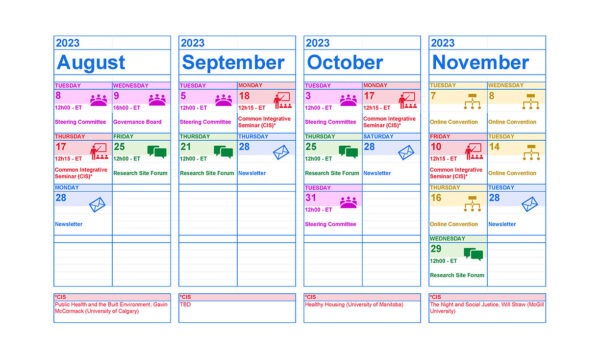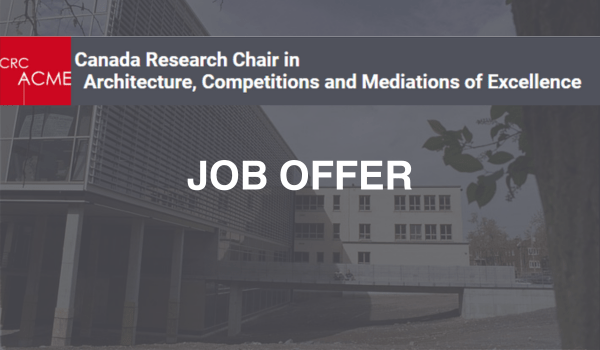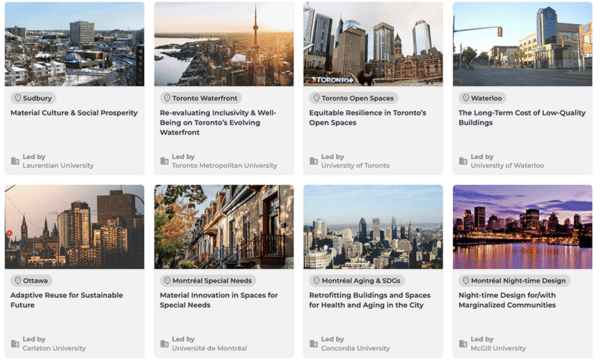How do you define quality in our public buildings and landscapes? This question is complicated and has no clear answer. Thankfully critically important new research is helping create better definitions and reformulate how we design, build, and evaluate the spaces we live, work, learn, and play.
In 2022, The Government of Canada Social Sciences and Humanities Research Council (SSHRC) funded a five-year project to build out research in the area of quality of the built environment. This first of its kind partnership includes 14 universities, 70 researchers, and 68 public and private organizations who are all working together. The project is called Quality in Canada’s Built Environment: Roadmaps to Equity, Social Value and Sustainability.
The research partnership will bring us closer to the UN’s Sustainable Development goals of sustainable cities and communities and reduced inequality. It will improve quality in our urban spaces, buildings and landscapes across Canada by influencing future built environment policies and frameworks in the schools of architecture. Ultimately, it will improve the lives of millions of people including minorities and underrepresented populations.
The Rick Hansen Foundation is proud to be a partner of the SSHRC project in supporting research teams across Canada to include an accessibility lens in their definitions of quality in the built environment, and in co-designing new paths to equity, diversity and inclusion for people of all ages and abilities. The RHF team members involved in the project include:
- Doramy Ehling, CEO and member of the SSHRC Steering Committee;
- Kevin Ng, Director Content and Technical, RHF Accessibility Certification;
- Laura McBride, Director Marketing and Co-Chair of the SSHRC Dissemination and Outreach Committee.
We are now two years into the momentous undertaking. At the 3rd Annual SSHRC Partnership Convention on Quality, researchers and partners came together to unveil the first versions of the 14 roadmaps to quality.
The Halifax Convention
A major focus of the 14 projects over the last two years has been understanding the critical importance of lived experience
“Incorporating the diverse perspectives of people with lived experience is absolutely critical to identifying barriers and advancing meaningful accessibility,” said Doramy Ehling, Rick Hansen Foundation CEO. “This research will help to change design culture and improve quality by bringing these voices to the forefront”.
“Lived Experience is about the personal knowledge, perceptions, and feelings within a world within which we live,” the Living Atlas of Quality in Architecture and the Built Environment website explains. “It has now become a major feature of the 14 situated projects across Canada to learn the best ways to collect ‘lived experiences’ of quality. This practice aims to raise our understanding of the actual meaning of quality in the everyday life of non-experts.”
All partners were invited to report on one positive output based on their own experience of the project after two years, alongside a presentation of their initial working roadmap to quality, shifting the focus from purely knowledge-based strategies to actionable plans.
These roadmaps, tailored to specific local contexts, offered unique approaches to achieving higher quality. They were designed to answer the pressing question: How can we raise the level of quality swiftly and effectively across diverse built environments? By incorporating the diverse perspectives of citizens, cities, professionals, researchers and First Nations, and focusing on equity, social value, and sustainability, these roadmaps offer a blueprint for creating more resilient and inclusive communities.
The following is a brief summary of three of the exciting research projects that focus on accessibility. For more information on all 14 projects, visit the Living Atlas of Quality in the Built Environment website.
Designing Inclusive, Sustainable & Healthy Cities (University of Calgary)
The team at the University of Calgary is considering design of the built environment in three ways: as a vehicle to foster inclusivity, to heighten sustainability and to improve public health. They are asking important questions about how our understanding of design excellence be broadened, beyond a current focus on form and aesthetics and how we can reconsider out spaces to respond to broader definitions and understanding of quality in the built environment.
Re-evaluating Inclusivity & Well-Being on Toronto’s Evolving Waterfront (Toronto Metropolitan University)
Barriers based on social, economic and other non-physical forms of exclusion can limit access to the Toronto waterfront and the amenities it offers. This research team is seeking to better understand how design excellence is understood how people with different mobility, sensory and cognitive abilities experience the Toronto waterfront, bringing in the intersection of lived experience, architecture and public space.
Equitable Resilience in Toronto’s Open Spaces (University of Toronto)
This project will provide much-needed research on how to improve the access, functionality, and quality of public parks to increase equity for Toronto’s underserved populations. It will look to better understand the opportunities and barriers to park improvements including how we increase the legibility and understanding of the value of public open space as critical infrastructure.
Material Innovation in Spaces for Special Needs (University de Montreal)
This research proposes to redefine quality in architecture through an inclusive design approach that promotes health and well-being while addressing critical aspects often neglected by norms. In this framework, design thinking is challenged not only by the specific phenomena linked to aging and special needs but also by the often contradictory and counterproductive effects of standards for security.
Moving Forward: The Next Three Years
The Halifax Convention marks a pivotal time for design culture in our country, providing a platform to share innovative strategies and foster collaboration, and highlighting the importance of diverse voices in shaping our communities.
We look forward to sharing insights from this critically important research as it translates into the hands of people and organizations who will put it to practical use.
Follow this project on LinkedIn to stay up-to-date on the latest findings.


